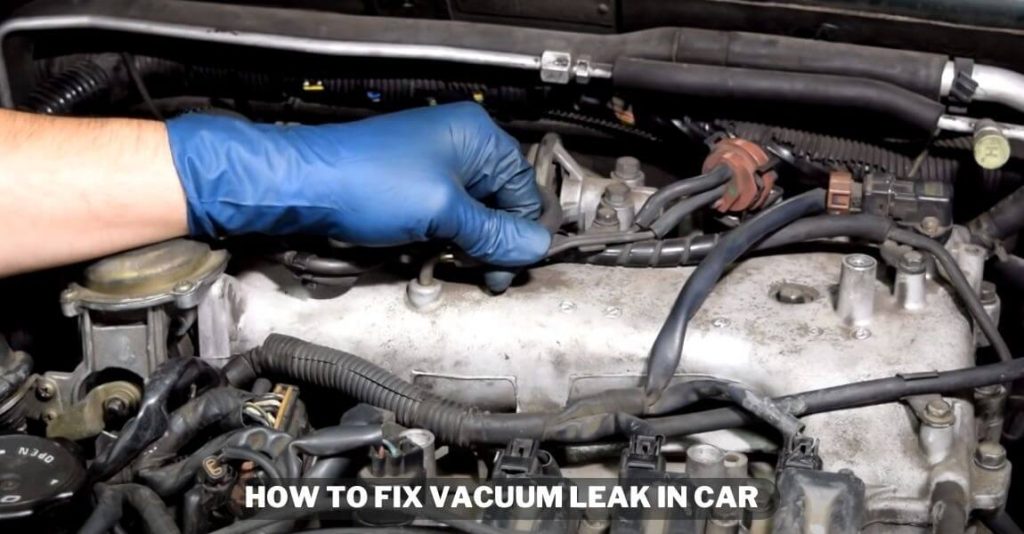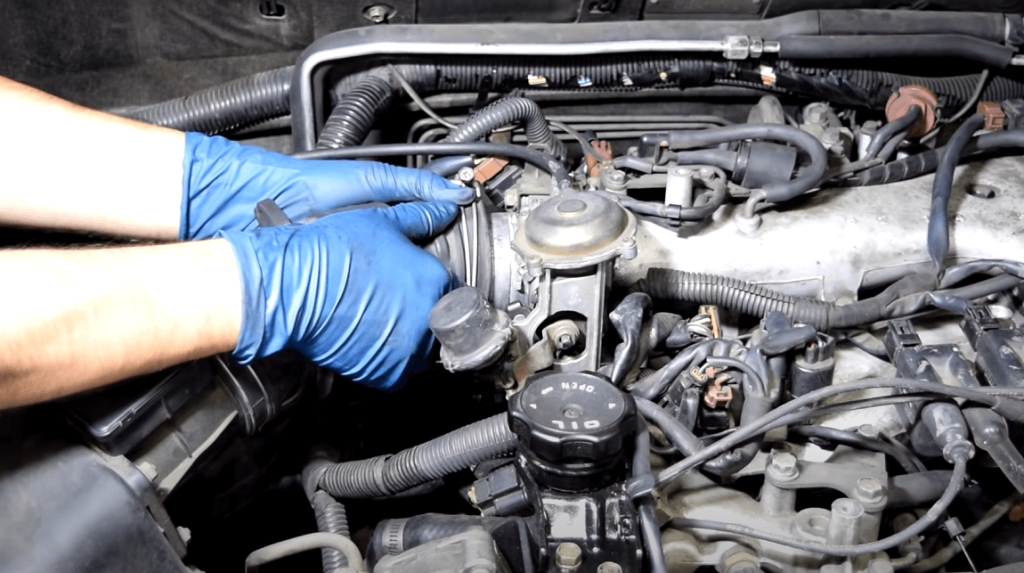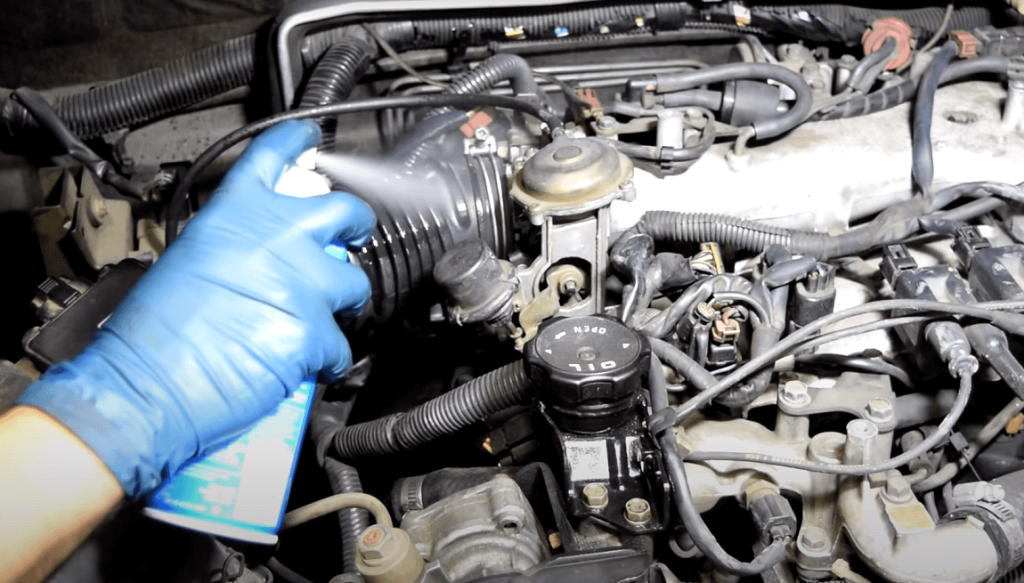This article was updated in August 30, 2023 with new products and information by Mark S. Taylor
To fix a vacuum leak in a car, locate the damaged hose and secure or replace it. It is important to fix a vacuum leak promptly to maintain optimal engine performance and fuel efficiency.
Introducing a vacuum leak in a car can lead to a range of issues, including reduced engine power, poor fuel efficiency, and potential damage to engine components. A vacuum leak occurs when there is an unintended and excessive air intake into the engine due to a damaged or disconnected vacuum hose.
This disrupts the delicate balance of air and fuel mixture required for combustion, resulting in a variety of problems. However, fixing a vacuum leak is relatively straightforward. By identifying the damaged hose and either securing it or replacing it, you can restore proper engine function, ensuring optimal performance and fuel efficiency.

Contents
Signs Of A Vacuum Leak
If you’re experiencing issues with your car’s performance, it’s possible that you have a vacuum leak. A vacuum leak occurs when there is an unwanted amount of air entering the engine. This can lead to a variety of problems that can affect the overall drivability and efficiency of your vehicle.
Here are some common signs that indicate the presence of a vacuum leak:
- Rough idling: One of the most noticeable signs of a vacuum leak is a rough or uneven idle. You may notice that your engine is running erratically or vibrating more than usual when you’re at a stop. This can be due to an imbalance in the air-fuel mixture caused by the extra air entering the engine through the leak.
- Decreased fuel efficiency: A vacuum leak can disrupt the proper fuel-to-air ratio, causing your engine to consume more fuel than necessary. If you find that you’re making more frequent trips to the gas station despite driving the same distance, a vacuum leak could be to blame.
- Stalling or hesitation: Another indication of a vacuum leak is stalling or hesitation when you accelerate. The additional air entering the engine can disrupt the combustion process, leading to a lack of power and inconsistent acceleration. You may feel a momentary loss of power or notice that your engine hesitates before responding to the gas pedal.
- Check engine light: In some cases, a vacuum leak may trigger the check engine light on your dashboard. Modern vehicles are equipped with sensors that detect abnormalities in the engine’s performance, including variations in the air-fuel mixture. If a vacuum leak is detected, the check engine light will illuminate to alert you of the issue.
If you experience any of these signs, it’s important to address the vacuum leak as soon as possible. Ignoring the problem can lead to further damage to your engine and potentially more expensive repairs down the line. It’s best to consult a professional mechanic who can diagnose the issue and recommend the appropriate solution.
Locating The Vacuum Leak
If your car is showing symptoms of a vacuum leak, such as rough idling or a decrease in engine performance, it’s crucial to locate the source of the problem as soon as possible. A vacuum leak can lead to a variety of issues, including poor fuel efficiency and potential damage to engine components.
In this section, we’ll explore the primary areas to inspect when looking for a vacuum leak.
Inspect Vacuum Hoses And Lines
- Start by visually inspecting all vacuum hoses and lines connected to the intake manifold and throttle body.
- Look for any signs of cracks, splits, or loose connections.
- Pay particular attention to areas where the hoses connect to other components, as these junction points are often prone to leaks.
- Ensure that the hoses are securely attached and that there are no signs of wear or deterioration.
Check Intake Manifold Gasket
- The intake manifold gasket plays a crucial role in maintaining a proper seal between the intake manifold and the engine block.
- Inspect the gasket for any signs of damage or deterioration, such as cracks or warping.
- If there are visible issues with the gasket, it may be the source of the vacuum leak.
- Consider using a vacuum gauge to test for any fluctuations in pressure that could indicate a leak around the gasket.
Examine Throttle Body Gasket
- The throttle body gasket is located between the throttle body and the intake manifold, regulating the airflow into the engine.
- Inspect the gasket for any signs of wear, tears, or damage.
- Even a small gap or crack in the gasket can lead to a vacuum leak and affect engine performance.
- Consider removing and replacing the gasket if it shows any signs of deterioration.
Remember, properly locating the source of a vacuum leak is crucial for effectively fixing the issue. By inspecting the vacuum hoses and lines, checking the intake manifold gasket, and examining the throttle body gasket, you’ll be well on your way to identifying and resolving any vacuum leak problems in your car.
Repairing The Vacuum Leak
If your car is experiencing a vacuum leak, it’s important to address the issue promptly to prevent further damage and maintain optimal performance. Repairing a vacuum leak may sound intimidating, but with the right steps, you can tackle this problem effectively.
Follow these steps to identify and fix a vacuum leak in your car.

Step 1: Identify The Source Of The Leak
To fix a vacuum leak, you first need to locate the source. Here’s how you can do it:
Listen for hissing sounds: A vacuum leak often produces a distinct hissing sound. Start your car and listen for any unusual noises under the hood, particularly around the intake manifold, vacuum hoses, and gaskets.
Inspect rubber hoses: Check for any cracked, damaged, or loose rubber hoses. These are often common culprits of vacuum leaks. Look for visible signs of wear, such as splits or disconnections.
Check the intake manifold gasket: One of the critical areas to inspect is the intake manifold gasket. A worn or damaged gasket can lead to vacuum leaks. Inspect it carefully for any signs of wear or cracks.
Step 2: Clean The Affected Area
Once you’ve identified the source of the vacuum leak, it’s essential to clean the affected area before proceeding with any repairs. Follow these steps:
- Remove dirt and debris: Use a clean cloth or mild cleaning solution to clean the area around the leak. Removing any dirt or debris will help you get a better view and ensure a proper seal.
- Use a wire brush: Gently scrub the affected area with a wire brush to remove any built-up residue. This will help create a clean surface for the repairs.
- Let it dry: Allow the area to dry completely before proceeding to the next step. Moisture can impact the effectiveness of the repairs, so ensure everything is dry before moving forward.
Step 3: Replace Damaged Hoses Or Gaskets
Replacing damaged hoses or gaskets is crucial to fix a vacuum leak. Here’s what you need to do:
- Remove the old component: If you’ve identified a damaged hose or gasket, carefully disconnect it from the intake manifold or other connecting points. Follow any specific instructions provided by your car’s manufacturer.
- Install the new component: Take the new hose or gasket and position it correctly, ensuring a snug fit. Double-check that all connections are secure.
- Tighten clamps: If applicable, use clamps to secure the hose or gasket in place. Make sure they are tightened adequately to prevent any leakage.
Step 4: Test The Repairs
Once you’ve completed the necessary repairs, it’s pivotal to test the system to verify that the vacuum leak has been fixed. Follow these steps:
- Start your car: Turn on your car’s engine and let it run for a few minutes.
- Listen for hissing sounds: Pay attention for any hissing sounds that might indicate a remaining leak. If you hear any, revisit the previous steps to identify and address the issue.
- Monitor performance: Observe how your car is running. Note any improvements in performance, such as smoother acceleration or better fuel efficiency. If everything seems normal, congratulations – you’ve successfully repaired the vacuum leak!
Remember, if you’re unsure or uncomfortable with performing the repairs yourself, it’s always best to consult a professional mechanic. They have the expertise to diagnose and fix complex vacuum leaks and ensure your car is in top shape.
Common Diy Fixes
If you suspect a vacuum leak in your car, there are several common diy fixes you can try before taking your vehicle to the mechanic. These simple solutions can help you save time and money while ensuring your car runs smoothly.
Here are a few methods you can employ:
Applying Silicone Sealant:
- Locate the source of the vacuum leak using a smoke machine or by performing a visual inspection.
- Clean the area around the leak with a rag and some rubbing alcohol to ensure a proper seal.
- Apply a small amount of silicone sealant directly to the leak, covering it completely.
- Wait for the sealant to dry and cure according to the manufacturer’s instructions.
- Test your car for any remaining vacuum leaks.
Using Hose Clamps:
- Identify the loose or damaged hose causing the vacuum leak.
- Remove the hose from the affected area carefully.
- Examine the hose for any cracks or signs of wear and tear.
- If necessary, cut off the damaged portion of the hose using a blade or scissors.
- Slide a hose clamp onto the hose and position it on the affected area.
- Tighten the hose clamp securely to ensure a tight seal.
- Test your car for any remaining vacuum leaks.
Replacing Gaskets:
- Locate the gasket that is causing the vacuum leak. It is often found between two engine components.
- Remove the old gasket carefully, ensuring not to damage the surrounding parts.
- Clean the mating surfaces thoroughly with a rag and some solvent.
- Apply a thin layer of gasket sealant to both sides of the new gasket.
- Place the new gasket onto the mating surfaces and ensure proper alignment.
- Reassemble the components and tighten any bolts or screws as necessary.
- Test your car for any remaining vacuum leaks.
Installing A Smoke Machine:
- Acquire a smoke machine specifically designed for testing car systems.
- Connect the smoke machine to the vacuum line or intake system of your vehicle.
- Activate the smoke machine, allowing it to fill the system with smoke.
- Inspect your car for any signs of smoke escaping, indicating a vacuum leak.
- Identify the source of the leak and address it using the appropriate method mentioned above.
- Re-test your car using the smoke machine to ensure all vacuum leaks have been fixed.
By following these common diy fixes, you can effectively tackle vacuum leaks in your car without the need for professional assistance. Remember to take your time, be thorough, and test your car after each repair to ensure a successful fix.

Professional Solutions
Fixing a vacuum leak in your car requires a certain level of expertise and specialized equipment. While some DIY enthusiasts may attempt to tackle the issue on their own, it’s often recommended to seek professional help to ensure a proper and lasting solution.
Here are some professional solutions you can consider for fixing a vacuum leak in your car:
Visiting A Trusted Mechanic
When it comes to resolving a vacuum leak, visiting a trusted mechanic is a wise choice. These professionals have the knowledge and experience to identify and fix the issue effectively. Here’s what you can expect when you visit a mechanic:
- Thorough inspection: A mechanic will conduct a comprehensive inspection of your car’s vacuum system to identify any leaks or faulty components.
- Diagnostic equipment: They will use advanced diagnostic equipment to pinpoint the exact location of the leak, saving you time and money in the long run.
- Expertise in repair: Experienced mechanics possess the expertise to repair or replace the affected components, ensuring a reliable fix.
Utilizing Smoke Test Equipment
Smoke testing is a common technique used by mechanics to detect and locate vacuum leaks efficiently. The process involves introducing smoke into the vacuum system, which will escape through any leaks, making them easily visible. Here’s how smoke test equipment can help:
- Quick leak detection: Smoke test equipment allows mechanics to quickly locate the source of the vacuum leak, saving time and effort.
- Accurate identification: The smoke will clearly reveal leaks in hoses, connections, or other components, ensuring these areas receive proper attention.
- Comprehensive analysis: By using smoke testing, mechanics can identify multiple leaks that might be present in the system, enabling thorough repairs.
Repairing Or Replacing Affected Components
Once the vacuum leak is identified, the mechanic will proceed with repairing or replacing the affected components. Here’s how this process typically unfolds:
- Component repair: If the leak is minor, the mechanic may be able to repair the affected component, such as a cracked hose or loose connection, restoring proper vacuum flow.
- Component replacement: In some cases, the damaged component might need to be replaced entirely. This ensures a long-lasting fix and prevents future leaks.
- System reassembly and testing: After the repair or replacement, the mechanic will reassemble the vacuum system and conduct thorough testing to ensure there are no remaining leaks or issues.
Working with a professional offers peace of mind, as they possess the necessary skills and tools to fix a vacuum leak in your car effectively. Remember, it’s essential to address any vacuum leaks promptly to prevent further damage and maintain optimal performance.
Preventing Vacuum Leaks
Regularly inspecting hoses and connections:
- Routinely check the condition of all vacuum hoses, paying close attention to any signs of wear or damage.
- Look for cracks, splits, or loose connections that could cause air leakage.
- Ensure all connections are secure and properly attached.
- Replace any worn or damaged hoses immediately to prevent potential vacuum leaks.
Avoiding excessive engine stress:
- Excessive engine stress can lead to vacuum leaks, so it’s important to drive responsibly and avoid aggressive driving techniques.
- Avoid abrupt acceleration and sudden braking, as these actions can put unnecessary strain on the engine.
- Smooth and gradual acceleration and deceleration help to maintain optimal engine performance and reduce the risk of vacuum leaks.
Following recommended maintenance schedule:
- Adhering to the manufacturer’s recommended maintenance schedule is crucial in preventing vacuum leaks.
- Regularly servicing your vehicle, including scheduled tune-ups and inspections, can help identify and address potential vacuum leak issues before they worsen.
- Schedule routine inspections and maintenance at a trusted mechanic or dealership to ensure your vehicle is in optimal condition and avoid any surprises down the road.
Remember, preventing vacuum leaks is key to maintaining the overall health and performance of your car. Regularly inspecting hoses and connections, avoiding excessive engine stress, and following a recommended maintenance schedule can minimize the risk of vacuum leaks and enjoy smooth and trouble-free drives.
Take care of your car, and it will take care of you.
Frequently Asked Questions On How To Fix Vacuum Leak In Car
Q: What Are The Signs Of A Vacuum Leak In A Car?
A: Common signs of a vacuum leak in a car include rough idling, decreased engine performance, hissing sounds, and the check engine light turning on. If you notice any of these symptoms, it’s essential to address the issue promptly to prevent further damage to your vehicle.
Q: How Does A Vacuum Leak Affect The Car’s Performance?
A: A vacuum leak can disrupt the air-to-fuel ratio in the engine, leading to poor combustion and decreased performance. This can result in issues such as loss of power, hesitation, and increased fuel consumption. It’s crucial to fix any vacuum leaks to ensure optimal engine performance.
Q: Can I Fix A Vacuum Leak In My Car By Myself?
A: While some vacuum leaks can be fixed by DIY enthusiasts, it’s recommended to have a professional inspect and repair the issue. Identifying the specific location of the leak can be challenging, and using the wrong tools or techniques could cause further damage.
Consulting a mechanic is the best course of action for a proper fix.
Conclusion
Fixing a vacuum leak in your car is crucial for maintaining its performance and efficiency. By addressing this issue, you can prevent potential damage to your engine and save money on fuel costs. Ensuring a tight seal between the intake manifold and other components will eliminate air leaks and optimize the engine’s combustion process.
Start by identifying the source of the leak using methods such as visual inspection, smoke testing, or the use of a vacuum gauge. Once located, you can take steps to repair the leak, such as replacing damaged hoses or gaskets.
Regular maintenance and prompt repair of vacuum leaks will keep your car running smoothly and extend its lifespan. Remember, a well-maintained engine not only improves performance but also reduces emissions, contributing to a cleaner environment. Don’t let a vacuum leak go unnoticed – fix it today and enjoy the benefits of a properly functioning car.
